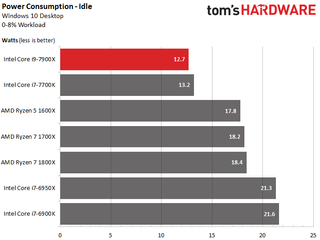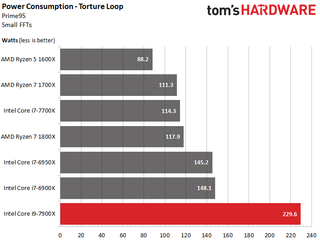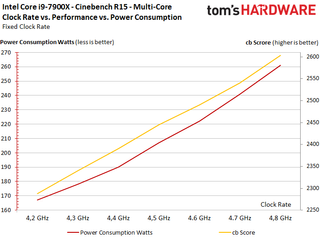Intel Core i9-7900X Review: Meet Skylake-X
Why you can trust Tom's Hardware
Power Consumption & Overclocking
Intel isn't using a soldered integrated heat spreader (IHS) for Skylake-X and Kaby Lake-X. Instead of the metallic solder most enthusiasts want to see, heat moves from the die to the IHS through inexpensive thermal interface material, which is just a fancy name for common thermal paste. This decision has implications for both our power consumption measurements and overclocking efforts.
First, we had to use our industrial-grade Alphacool Eiszeit Chiller 2000 cooler to achieve meaningful test results. Air cooling is out of the question for Core i9-7900X, and even a decent all-in-one liquid cooling solution won’t get far.

Power consumption is measured after the voltage converters and CPU, using points on the motherboard. The 230A we saw during our overclocking tests prompted us to add a fan to the motherboard. We only had one platform for this story, so we played it safe with extra cooling around the LGA interface.
Power Consumption
These numbers are generated using stock motherboard settings; any significant under-volting had no effect, except to cause stability problems.
At idle, the Core i9-7900X comes in below its predecessor and AMD’s Ryzen models. Getting there required a firmware update to correct problems with P-states, among other issues plaguing this platform right up until launch.

Even lightly threaded workloads like AutoCAD 2015, which uses just a few of the Core i9-7900X’s cores, catapult Intel’s -7900X to the back of the pack in power consumption metrics.
This is almost certainly due to higher clock rates than previous-gen HEDT CPUs like the Core i7-6950X. Taking into account Skylake-X's increased performance, though, the Core i9-7900X remains a more efficient solution. One percent more power consumption gets you 29 percent more 2D performance and a massive 39 percent more 3D performance. Both tasks profit from Turbo Boost Max Technology 3.0 in a big way.

If more than three cores are used, the Core i9-7900X’s advantage shrinks considerably. It still beats the Core i7-6950X by approximately 17 percent, but the power consumption increase is a lot larger (around 10 percent).

Pushing all of the Core i9-7900X’s cores with Prime95 or LuxRender propels power consumption to incredible heights. You do get 48 percent more rendering performance in LuxRender, but at the expense of 58 percent-higher power use. This approach has the elegance of a sledgehammer. Then again, if you need speed at any cost, Core i9-7900X is top-notch.

Overclocking and Stability
We now know that the Core i9-7900X’s performance to power consumption ratio turns negative as you utilize more of its on-die resources. Of course, this has to be factored into your overclocking plans, since many coolers can't cope with the heat dissipated by a >200W processor.
Stable overclocking, defined as reliable operation under Prime95 for prolonged periods of time without hitting a temperature limit, wasn’t possible beyond 4.4 GHz. Reports of >5 GHz with all cores active should be taken with a grain of salt. We did boot into Windows at 5.1 GHz, but running actual applications resulted in either a BSOD or a motherboard emergency shutdown.
We did manage to achieve a stable 4.8 GHz overclock under the single- and multi-core Cinebench R15 benchmarks. However, our cooling solution was probably the decisive factor there. Realistically, 4.5 GHz should be achievable with an all-in-one liquid cooler. Let’s take a look at the comparison curves for Cinebench R15 with all cores active:

At a Vcore of 1.4V, the system stayed stable for 10 benchmark runs. Intel's Core i9-7900X consumed an average of 261W, while individual peaks jumped as high as 293W. A test at 4.8 GHz using 20 instances of a year-long shading computation for a rooftop photovoltaic array, including profit calculation, pushed power consumption all the way to 335W. The motherboard shut down after we started Prime95 without limiting AVX. The last recorded value was 364W.
The performance and power consumption curves yield some interesting findings. Performance scales with clock rate in an almost linear fashion. Power consumption increases faster, but not as rapidly as we feared that it might.

The more pronounced curve is due to relatively high values at lower frequencies, where the “background noise” (load caused by other system components) is more noticeable.
So, what’s the final verdict on overclocking Intel's Core i9-7900X? It depends on the quality of your cooler and its ability to move heat off the CPU as quickly as possible.
MORE: Best CPUs
MORE: Intel & AMD Processor Hierarchy
MORE: All CPU Content
Current page: Power Consumption & Overclocking
Prev Page Workstation & HPC Next Page Temperature & Thermal ProblemsStay on the Cutting Edge
Join the experts who read Tom's Hardware for the inside track on enthusiast PC tech news — and have for over 25 years. We'll send breaking news and in-depth reviews of CPUs, GPUs, AI, maker hardware and more straight to your inbox.
-
Pros: 10/20 cost now $999Reply
Cons: Everything else
My biggest problem with this Intel lineup is that if you want 44 PCIe you have to pay $999. No, thanks. My money goes to AMD ThreadRipper.
Good review! -
rantoc Doubt many who purchase such high end cpu for gaming runs at a low full hd 1080p resolution, i know its more cpu taxing to run lower res at higher fps but that's for the sake of benchmarking the cpu itself.Reply
I would like to see 1440p + 2160p resolutions on a suitable high end card (1080ti or equalent) benchmarked with the cpu as well as it would represent real scenarios for the peeps considering such cpu.
Thanks for a good review! -
James Mason So it seems like de-lidding the x299 processors is gonna be a standard thing now to replace the TIM?Reply -
elbert Meet netburst 2.0 that not only can hit 100c at only (4.7Ghz)1.2v on good water cooler but only barely beats a 7700k not overclocked in games. All this is yours for the low low price of 3X. Its slower than the old 6950x in a few tests with was odd.Reply -
James Mason Reply
The differences would be less noticeable at higher res than 1080p, so.... you'd just see less dissimilar numbers.19835717 said:Doubt many who purchase such high end cpu for gaming runs at a low full hd 1080p resolution, i know its more cpu taxing to run lower res at higher fps but that's for the sake of benchmarking the cpu itself.
I would like to see 1440p + 2160p resolutions on a suitable high end card (1080ti or equalent) benchmarked with the cpu as well as it would represent real scenarios for the peeps considering such cpu.
Thanks for a good review! -
Dawg__Cester Hmmmmm. I bought a Ryzen 1700, a water cooler, Asrock B350 MB, 16gb ram 3200Mhz for $590 plus tax. I live in New Jersey. I was very nervous about making the purchase as I knew this was coming out this week but the sale prices got me. Unless you all think I got ripped off, (DON'T TELL ME). But in all honesty I have not regretted the purchase one bit!! I even managed to save enough to get a GTX 1080 FE GPU. I did have a few bumps in the road getting the system stable (about 3 hours configuring after assembly) but I am VERY happy. I used Intel primarily and never really considered AMD other than for Video adapters and SSDs.Reply
After reading this along with other articles and YT videos, I have no regerts as I enjoy my Milky Way and play my games among other things.
Just my experience. I am not seeking positive reinforcement nor advice.
I just feel very satisfied that I did not wait and cough up 3oo more fore something I could have for less. I know, I know it makes no sense.
But come on fellas, its the computer game!! -
James Mason Reply19835862 said:Hmmmmm. I bought a Ryzen 1700, a water cooler, Asrock B350 MB, 16gb ram 3200Mhz for $590 plus tax. I live in New Jersey. I was very nervous about making the purchase as I knew this was coming out this week but the sale prices got me. Unless you all think I got ripped off, (DON'T TELL ME). But in all honesty I have not regretted the purchase one bit!! I even managed to save enough to get a GTX 1080 FE GPU. I did have a few bumps in the road getting the system stable (about 3 hours configuring after assembly) but I am VERY happy. I used Intel primarily and never really considered AMD other than for Video adapters and SSDs.
After reading this along with other articles and YT videos, I have no regerts as I enjoy my Milky Way and play my games among other things.
Just my experience. I am not seeking positive reinforcement nor advice.
I just feel very satisfied that I did not wait and cough up 3oo more fore something I could have for less. I know, I know it makes no sense.
But come on fellas, its the computer game!!
PCPartPicker part list / Price breakdown by merchant
CPU: AMD - Ryzen 7 1700 3.0GHz 8-Core Processor ($299.39 @ SuperBiiz)
Motherboard: ASRock - AB350M Micro ATX AM4 Motherboard ($65.98 @ Newegg)
Memory: G.Skill - Ripjaws V Series 16GB (2 x 8GB) DDR4-3200 Memory ($124.99 @ Newegg)
Total: $490.36
Prices include shipping, taxes, and discounts when availableGenerated by PCPartPicker 2017-06-19 10:47 EDT-0400
Depends on which watercooler and which ram, but not really. -
Jakko_ Wow, compared to the Ryzen 1800X, the Intel Core i9-7900X:Reply
is about 25-30% faster
costs 105% more
uses 35-40% more power
Ryzen looks really good here, and together with the temperature problems, Intel seems to be in some deep shit. -
HardwareExtreme Too little, too late. Does Intel really think that just because it has "Intel" written on it that it must be worth $200-$300 than AMD?Reply
